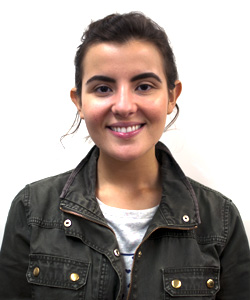
 Whether we realize it or not, information technology is taking over the world. The use of ‘Big Data’ and technology is becoming an important part of society, with applications not only in social networking, but also in business, social science and medicine.
Whether we realize it or not, information technology is taking over the world. The use of ‘Big Data’ and technology is becoming an important part of society, with applications not only in social networking, but also in business, social science and medicine.
Today, a degree in computer or data science seems to be a Millennial’s ticket to job security. Yet those outside of the field have only a small understanding of its impact. Information technology, or the study of data, is creeping into every field, industry and company.
Data scientists are experts at operating the tools that collect data. They’re trained to look for patterns and correlations in topics related to their respective fields.
Tom Negrete, an associate editor for CALmatters of Sacramento and a data science expert, explained how his non-profit publication works with universities to get access to more information on readers’ tastes and preferences. The publication tries to understand what readers enjoy and produce stories accordingly.
With the amount of information and resources available today, it won’t be hard to achieve that end.
“The rate of data being consumed and produced is growing exponentially,” Negrete explained. He also said that since tools used to collect data are becoming cheaper over time, companies, governments and data scientists can more effectively collect huge quantities of data and use it any way they like.
Huge companies like Target use data everyday for a wide range of purposes, including tracking consumer habits.
A 2012 data breach in the retailer’s system revealed to investigators the extent to which Target was researching its customers. Simply visiting the Target website enabled company analysts to drop a cookie on customers. This cookie allowed analysts to surveil a customer’s internet behavior. When a shopper used their credit card, Target would begin to track what was bought.
The company was able to develop algorithms to more effectively and efficiently highlight customer buying patterns. Based on key items purchased, analysts could begin to predict future behavior.
“[Target was] able to tailor brochures based on this knowledge,” Negrete said.
CALmatters and Target are only two examples of how industries are collecting and using information. Data analysis is also becoming an integral part of medical and social science research. Its uses in these disciplines don’t seem as intrusive as those in the business world.
Dr. Patrice Koehl, a UC Davis professor in Computer Science and Founding Advisor of the university’s Data Science Initiative, maintained that data science allows us to bridge informational gaps and obtain quicker answers to our problems.
The professor pointed to the Fitbit, a popular tool designed to track a person’s activity, as a subtle example of how data leveraging is becoming increasingly salient.
Doctors collect data from these mobile devices to track a patient’s medical statistics. With detailed information collected over a long period of time, doctors gain a greater understanding of their patients. It broadens their scope of knowledge far past what they might get from a short doctor-patient consultation.
Koehl expects further innovations in coming years.
“[Fitbits] might not be connected to your health records now, but they will be soon,” Koehl said.
Connections to health records would prompt data scientists to create algorithms for finding correlations and connections in a person’s health history from a time before that person starting using a Fitbit. Data science innovations could lead to a greater understanding of a person’s DNA and dietary needs by providing a more personalized view of medicine.
Koehl said that each party using data science finds its own way to benefit from the practice. He cited social science and humanities as fields where data science is making research much easier for literature experts, historians and others.
With scanning technology, it’s easy to determine where historical texts originated, who wrote them and when they were written. Algorithms have become the quickest way to analyze variables like handwriting patterns, word choice within the text, the type of ink used and the age of the paper material.
While understanding how data science works and its integral function in our world is not a top priority for most, remaining ignorant of its relevance would be a mistake.
In 2012, Koehl helped found UC Davis’ Data Science Initiative in an effort to integrate the discipline into some university programs. He was shocked to find that so few students knew about the uses of data science. The following year, he led a task force designed to discuss data science uses and issues on campus. The team was able to devise a broad plan to educate students properly on how to use data in the information era. Their goal was to encourage students to both broaden their knowledge of data science and to tackle issues of privacy and ethics when extracting information from the World Wide Web.
Since 2014, the Provost and Chancellor have been funding a data science initiative to implement the ideas of the task force, which included designating space on campus in Shields Library for people to collaborate on data-related projects and organizing workshops on topics like web-scraping and making sense of information on the web.
The university’s effort to make students aware of how information can be used is important. Given the capabilities of modern technology and the speed at which it is advancing, Generations Y and Z must understand both the benefits of data science across disciplines and the implications of hopping between sites, downloading files and sharing information through the Internet.
UC Davis is also organizing an official collaboration with the Lawrence Livermore National Laboratory. This science and technology-centered facility has recently restructured its budget to dedicate an impressive 10 percent to building more data science infrastructure.
“They’ve always worked with National Security, but now they’re applying data science techniques,” Koehl explained.
With so much collaboration, capital and manpower in play, it won’t be long before these advanced data and tracking techniques become accessible research tools across industries. “It’s only a matter of time before these resources become readily available; I’m not even talking about a matter of ten years,” Koehl said.
“We’re really just in our infancy, the beginning of the Big Data era. It’s just a tool that we’re learning to leverage,” Negrete said.
What does this mean, exactly? With sophisticated technology and research methods becoming so accessible, Millennials must keep pace. We need to start understanding these innovations better in order to protect our privacy from companies who invasively study our internet behavior and social media information and, of course, to become more productive in our professional fields.
Remaining vigilant of data science breakthroughs will be a critical part of prospering in the Information Age and educating the next generation on its role and impact on our society.
You can reach HAYLEY PROKOS at hprokos@ucdavis.edu or on Twitter @haroulii14



